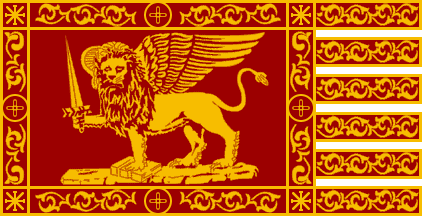 image by Jaume Ollé, Mello Luchtenberg & Tomislav Todorovic
25 June 2019
image by Jaume Ollé, Mello Luchtenberg & Tomislav Todorovic
25 June 2019"War Flag"

Last modified: 2025-03-01 by rob raeside
Keywords: serenissima |
Links: FOTW homepage |
search |
disclaimer and copyright |
write us |
mirrors
 image by Jaume Ollé, Mello Luchtenberg & Tomislav Todorovic
25 June 2019
image by Jaume Ollé, Mello Luchtenberg & Tomislav Todorovic
25 June 2019
"War Flag"
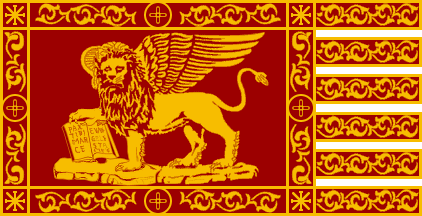 image by Jaume Ollé, Mello Luchtenberg & Tomislav Todorovic
25 June 2019
image by Jaume Ollé, Mello Luchtenberg & Tomislav Todorovic
25 June 2019
"Civil Flag"
See also:
The dark red and gold flag of the "Serenissima"
Republic of Venice (from early days until May 1797) is sparking
a harsh debate in Italy, because of the group of Venetian independentists who occupied (using a home-made tank) the Bell
Tower of St. Mark Square ten days ago and raised the flag.
Today the trial began in Venice and the online Italian newspaper
"la Repubblica" shows a nice picture of the flag
hanging from a balcony in town from which you can see the
peculiar "tails" of the flag. The main pattern on the
flag is, of course, the winged lion of St. Mark.
Alessio Bragadini, 21 May 1997
In the first page of the 10th of May edition of the PUBLICO
newspaper there was a photo of Umberto Bossi with flags. In it
you can see a very large "Serenissima" flag (a Venetian
flag in only gold and red) and behind it a smaller white flag,
partially visible. This Serenissima flag has been, apparently,
"adopted" by venetian independentists, although it is,
also, a "yacht ensign" of
Venice. A weird situation, to say the least.
Jorge Candeias, 13 May 2001
This flag is neither the actual flag of "Liga
Veneta" (= Northern League Venetian section), nor the flag
of the "Serenissimi" ("Serenisimi" in
Venetian language), independentist movement from Veneto, who
became famous in 1997 for having "conquered" for some
hours the famous Bell-Tower of St. Mark in Venice.
The "Serenissima" (or "Serenisima" in
Venetian) was the flag of the Repubblica di Venezia
("Repiovega de Venesia" in Venetian: the Venetian
language, often but wrongly considered an "Italian
dialect" was the official language of that State) and always
showed a lion holding a book with the Latin words "PAX TIBI
MARCE EVANGELISTA MEVS" (Peace upon You, o Mark!, My
Evangelist!) and not a sword. I'm quite sure the variant with the
sword was the war flag of the "Serenisima Repiovega de
Venesia". I think the error was due to the fact that the
"Serenisimi" (maybe) waved a "war flag" over
the Bell-Tower of St. Mark, because in their intention it was a
"war act" to release Venice from "Italian
domination".
Paolo Montanelli, 20 March 2003
I've seen recently the new secretary Matteo Salvini on TV with a "civil
version" of the Serenissima looking slightly different (http://www.ilsussidiario.net/News/Politica/2013/3/26/RISOLUZIONE-44-Dal-Veneto-un-referendum-che-puo-cambiare-Italia-ed-Europa-/374608/).
Paolo Montanelli, 23 January 2014
See also: Lega Nord Veneto - Liga Veneta
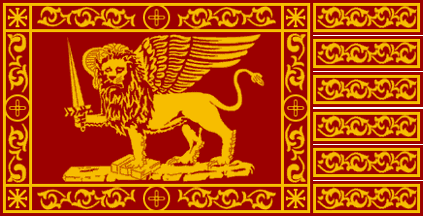 image by Jaume Ollé, Mello Luchtenberg & Tomislav Todorovic
25 June 2019
image by Jaume Ollé, Mello Luchtenberg & Tomislav Todorovic
25 June 2019
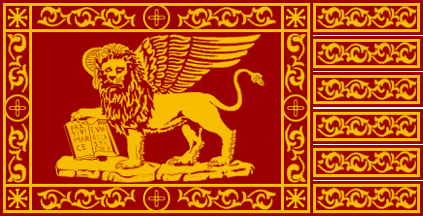 image by Jaume Ollé, Mello Luchtenberg & Tomislav Todorovic
25 June 2019
image by Jaume Ollé, Mello Luchtenberg & Tomislav Todorovic
25 June 2019
While the general design of these flags remains the same, there are many
details which may vary, sometimes almost to the extent of resulting in virtually
different flags:
The lion usually has the aureole, either "solid" [1, 2]
or voided [3], but may also lack it [4], which is frequently the case with the
"war flag" [5, 6]. The compartment is another detail which may sometimes be
omitted [4, 7, 8]. When the book is open, the pages are usually gold, but may be
white sometimes [9, 10, 11, 12]. The field, upon which the lion is placed, is
usually plain, but may sometimes be diapered [9, 10]. In most of cases, only one
lion's wing is visible [1, 2, 3, 5, 6, 8, 9, 11], although the other one may be
partly shown as well [4, 7, 10].
While the flags may have just the gold
fimbriation along the edges [3, 13], there is almost always a red border around
the whole pattern [11, 12]. In most of cases, the ornaments on the tongues
additionally have their own separate golden frame [1, 2, 4, 5, 6, 7, 8, 9, 14].
Width of red border may vary along different edges of the same flag.
The
flags without the red outermost border are presented at it-ven.html#ser
Although the flags are meant to be gonfanons, the tongues are
frequently not separated. That is usually case with the flags without the
outermost red border [3, 15], the gold fimbriation often being turned into a
very wide border [16, 17, 18], as also shown here.
Flags with the outermost red border may also be shaped like this, usually with a
gold [19] or white stripe [4] between the tongues' patterns. While this may look
like unfinished product, with printed guidelines for cutting between the
tongues, there are photos [4] which reveal stitches along the fly edge, so those
flags are clearly complete as such.
Sources:
[1] Flickr - Flag of
Venice, photographed on 2010-07-07:
https://www.flickr.com/photos/reidlromeo/4770899082/in/set-72157624311394906/
[2] Flickr - Flag of Venice, photographed on 2008-06-10:
https://www.flickr.com/photos/vt_professor/2584281741/
[3] Facebook -
Ilaria Brunelli's photo gallery, photo added on 2015-04-24:
https://www.facebook.com/ilariabrunellibdg/
[4] Vendita Bandiere website:
https://www.vendita-bandiere.it/bandiera-per-auto-italia-repubblica-di-venezia-697-1797-30-x-40-cm.html
[5] Il Gazzettino website:
https://sport.ilgazzettino.it/
[6] 123rf.com photo archive:
https://www.123rf.com/photo_67727605_flag-of-venice-main-symbol-of-venice-the-golden-winged-lion-of-evangelist-mark.html
[7] Bandiere Venete website:
http://www.bandierevenete.it/catalogo_prodotti/bandiera_repubblica_veneta_dim_150x80_cm_-_leone_del__700.html
[8] Bandiere Venete website:
http://www.bandierevenete.it/catalogo_prodotti/bandiera_repubblica_veneta_dim_150x80_cm_-_leone_con_spada_del__700.html
[9] Alamy photo archive:
https://www.alamy.it/vittorio-veneto-italia-23-settembre-2018-rievocazione-storica-con-persone-vestite-come-ottocento-militari-della-repubblica-di-venezia-image222565277.html
[10] Facebook - Antonio Guadagnini's photo gallery, photo added on
2015-10-06:
https://www.facebook.com/721483264601661/
[11] Flag of Venice at eBay:
https://www.ebay.it/itm/123759110960
[12] Flag of Venice at eBay:
https://www.ebay.it/itm/123759110960
[13] Treviso Today website:
http://www.trevisotoday.it/politica/laura-puppato-bandiera-veneta-treviso-29-agosto-2017.html
[14] Depositphotos photo archive:
https://it.depositphotos.com/11110926/stock-photo-venice-flag.html
[15]
Venice-tourism.com website:
http://www.venice-tourism.com/en/events/svolo-del-leon-fly-lion
[16]
Corriere del Veneto website:
https://corrieredelveneto.corriere.it/treviso/foto_del_giorno/2012/14-giugno-2012/furia-bandiere-201607956726.shtml
[17] La Voce di Venezia website:
https://www.lavocedivenezia.it/25-aprile-in-piazza-san-marco-albert-gardin-denunciato/
[18] Deskgram.net website:
https://deskgram.net/p/1802337754917264949_5351677271
[19] Notizie+
website:
https://notizieplus.it/dolomiti-montagne-venezia-turismo-vince/
Tomislav Todorovic, 27 June 2019
 image
provided by Andrea Gersich, 28 February 2025
image
provided by Andrea Gersich, 28 February 2025
[Click on image for larger version]
I am a member of the Società di Mutuo Soccorsa Carpentieri e Calafati, the last of the Schools of Venice (Scola = Confraternity of Arts and Crafts). Among the activities of the Society, there is also that of valorizing ancient Venetian traditions, and with this purpose, some years ago it was hypothesized to re-propose the celebration of June 15, when in 1310 the conspirators, led by Bajamonte Tiepolo, attempting a coup d'état, to kill the Doge Gradenigo and transform the Republic into a Signoria, were defeated by the men loyal to the Doge, including the Arsenalotti (Carpenters and Calafati of our School).
Also contributing to the defeat of the rebels was the intervention, perhaps incidental, of Giustina Rossi, an old lady, who, hearing all the racket under her house, opened the window and dropped a heavy mortar on the head of the standard-bearer of Bajamonte, who, losing his hand on the flag, created panic among the troops.
At the end of the battle, the Doge and the Senate of the Republic granted Giustina two "graces": The first was economic, blocking the cost of renting the house in which she lived (which belonged to the State) for her and all her descendants. The second, and here vexillology comes into play, was granted to the heroine the honor of being able to display a special flag at her window, every 15th June. This flag was displayed every year until the fall of the Republic, at the hands of Napoleon, in 1797.
Here ends the ancient story, but as we were saying, nowadays it was thought to restore this ancient tradition with a historical parade through the streets of Venice, perhaps displaying a flag on the historic window. By doing some studies on how this ancient flag could be made, with the help of the director of the Correr Museum in Piazza San Marco, we discovered thanks to a very old photo, that the flag still existed! After an adventurous search among the Museum's deposits, in an old attic we finally found this incredible banner complete with its golden leather case.
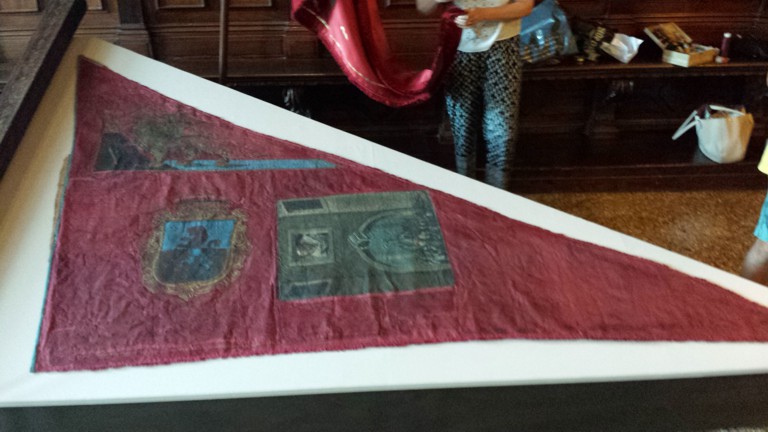 image
provided by Andrea Gersich, 28 February 2025
image
provided by Andrea Gersich, 28 February 2025
[Click on image for larger version]
A red silk banner, triangular in shape (2.40 x 1.70 meters), decorated in
gold leaf, silver leaf and fat tempera.
The symbols that appear on it are:
It was displayed every 15th June at the Mercerie dell’Orologio, in memory of the escaped danger faced by the Serenissima Republic. It was displayed for the last time on 15th June 1797 with the French troops already in the city for a month.
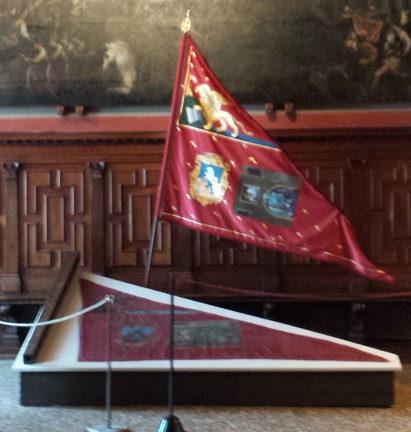 image
provided by Andrea Gersich, 28 February 2025
image
provided by Andrea Gersich, 28 February 2025
[Click on image for larger version]
At this point the original
flag was restored by the descendants of the noble Pisani family, and an exact
copy was created, applying all the ancient painting and gilding techniques by
the students of the Liceo Artistico Statale of Venice, in order to be able to
display it again every 15th June. The original was then displayed to the
public at the Correr Museum. I am attaching some photos, with the hope that
you will use them on your beautiful site on the page dedicated to the
Serenissima Republic
of Venice.
Andrea Gersich, 28 February 2025